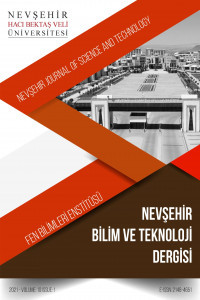Çevresel Su Örneklerinde GC/MSD ile Pestisit Analizi ve Metot Validasyonu
Pestisit, Su, Aldrin, Validasyon, GC/MSD
Pesticide Analysis and Method Validation with GC/MSD Instrument in Environmental Water Samples
Pesticide, Water, Aldrin, Validation, GC/MSD,
___
- [1] Matthews G. A., “Pesticides: Health, Safety and the Environment” Blackwell Publishing, 248s, Oxford, 2008
- [2] Laabs V., Amelung W., Pinto A. A., Wantzen M., da Silva C. J., Zech W., “Pesticides in Surface Water, Sediment, and Rainfall of the Northeastern Pantanal Basin” Brazil. Journal of Environmental Quality, 31, 1636-1648, 2002
- [3] Arslan H., “Investigation of the Usability of Andesite and Basalt Tubes for Dichlorvos (DDVP) Removal” Mersin University, Graduate School of Natural and Applied Sciences, MSc Thesis, 76s, Mersin, Turkey, 2000
- [4] Schwarzenbach R. P., Egli T., Hofstetter T. B., von Gunten U., Wehrli B., “Global Water Pollution and Human Health” The Annual Review of Environment and Resources, 35, 109-136, 2010
- [5] Aktar W., Sengupta D., Chowdhury A., “ Impact of Pesticide Use in Agriculture: Their Benefits and Hazards” Interdiciplinary Toxicology, 2, 1-12, 2009
- [6] Matsumara F., “Toxicology of Insecticides 2nd Ed.” Plenum Press, 598s, New York, 1985
- [7] Rand G. M., Petroçelli S. R., “Fundamentals of Aquatic Toxicology: Methods and Applications” Hemisphere Publishing Cooperation, 666s, Washington, 1985
- [8] Chau A. S. Y., Afghan B. K., “Analysis of Pesticides in Water” CRC Press Inc., 202s, Florida, 1982
- [9] Guthrie F. E., Perry J. J., “Introduction to Environmental Technology” Elsevier North Holland, 484s, New York, 1980
- [10] Beck H., Dross A., Mathar W., “PCDDs, PCDFs and related compounds in the German food supply” Chemosphere, 25, 1539-1550, 1992
- [11] Schaum J., Cleverly D., Lober M., Phillips L., Schweer G., “Updated analysis of U.S. sources of dioxin-like compounds and background exposure levels” Organohalogen Compounds, 20, 237–243, 1994
- [12] Egemen Ö., Sunlu U., “Su Kalitesi Ders Kitabı” Ege Üniversitesi Basımevi, 153s, Bornova, 1996
- [13] Dakeba R. W., McKenzie A. D., G. M. A. Lacroix, Cleroux C., Bowe S., Graham R. A., Conacher H. B. S., Verdier P., “Survey of arsenic in total diet food composites and estimation of the dietary intake of arsenic by Canadian adults and children” Journal of the AOAC International, 76, 14–25, 1993
- [14] Bizuik M., Przyjazny A., Czerwinski J., Wiergovski M., “Occurence and Determination of Pesticides in Natural and Treated Waters” Journal of Chromotography A, 754, 103-123, 1996
- [15] Guidance document on residue analytical methods, European Union, SANCO (825), 1999
- [16] Aboul-Enein H. Y. “Selectivity versus specificity in chromatographic analytical methods” Accreditation and Quality Assurance, 5, 180-181, 2000
- [17] Accreditation for chemical laboratories: Guidance on the interpretation of the EN 45000 series of standards and ISO Guide 25, Eurachem/Welec WGD2. Laboratory of the Government Chemist, Teddington, 1993
- [18] Accuracy (trueness and precision) of measurement methods and results Part 1: General principles and definitions, TS 5822-1 ISO 5725-1, Turkish Standards Institution, 2000
- [19] EEC Drinking Water Guidelines, 91/692/EEC, COM 789 Final 2016/0394 (COD), 2016
- [20] Miller J. C., Miller J. N., “Statistical in Analytical Chemistry (3rd ed.)” Ellis Horwood PTR Prentice Hall, 233s, NewYork, 1993
- [21] Portion of commodities to which codex maximum residue limits apply and which is analyzed, Codex Alimentarius Commiteee, Rome, 1993
- [22] Maximum residue levels of pesticides in or on food and feed of plant and animal origin, Council Directive (EC/ 396), 2005
- [23] Maximum residue level of pesticides in or on food and feed of plant and animal origin, as regards the implementing powers conferred on the commission, Council Directive (EC/299), 2008
- [24] OECD 617, Guidance Document on Pesticide Residue Analytical Methods, Environment, Health and Safety Publications, 2007
- [25] CITAC/EURACHEM Guide; The Fitness for Purpose of Analytical Methods. A Laboratory Guide to Method Validation and Related Topics, LGC UK: Middlesex, UK, s43, 1998
- ISSN: 2148-466X
- Yayın Aralığı: Yılda 2 Sayı
- Başlangıç: 2012
- Yayıncı: Nevşehir Hacı Bektaş Veli Üniversitesi
Polietilen ve Kereste Tozlarının Ko-pirolizi: Piroliz Ürün Değeri Üzerinde Polietilenin Etkisi
Sinem UĞUZ, Tolga AYERİ, Yüksel ARDALI
Tekstil Endüstrisi Atıksularının Arıtımında Kullanılan Proseslerin Araştırılması
Şakir ERDOĞDU, Ufuk KANDİL, Memduh NAS, Şirin KURBETCİ, Safa NAYIR
Muhammed Azim EIRGASH, Vedat TOĞAN, Aynur KAZAZ
Eskişehir’de Yer Alan Bazı Sulama Göletlerinin Su Kalitesinin Değerlendirilmesi
Arzu ÇİÇEK, Erhan UYSAL, Esengül KÖSE, Cem TOKATLI
Fenton ve Fotofenton Prosesleri ile Atıksudaki Aspirinin Giderim Verimliliğinin Karşılaştırılması
Sevde ÜSTÜN ODABAŞI, Bareera MARYAM, Hanife BÜYÜKGÜNGÖR
Hasan Hüseyin DERTLİ, Fezayil SUNCA, Mehmet AKKÖSE
Çevresel Su Örneklerinde GC/MSD ile Pestisit Analizi ve Metot Validasyonu
Bazalt Fiberle Güçlendirilmiş Doygun Silt Zeminin Mekanik Davranışının Deneysel İncelemesi
Cyrille Prosper NDEPETE, Sedat SERT
Bazı İlaç Kalıntılarının US ve US/H2O2 Prosesleri ile Giderimi
